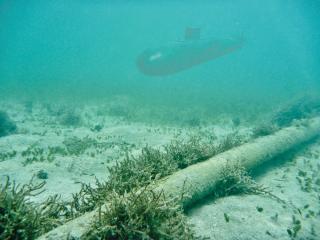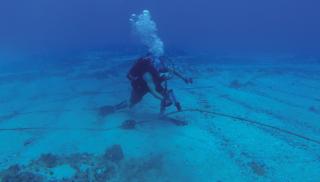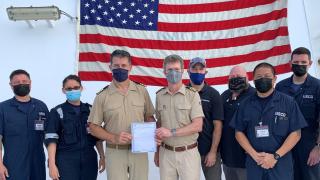Options to repair underseas fiber-optic cables in the event of war or sabotage are limited. This must change.
What should the U.S. government do when the transoceanic submarine fiber optic cables that supply, at the speed of light, more than 99 percent of the international voice, data, video, and internet communications between the United States and the rest of the world are damaged or cut during wartime? Declare an emergency? Then what?
Fortunately, Congress enacted a National Security Council–generated solution in 2019 with the Submarine Security Fleet law that addresses this situation in the context of a national emergency triggered by the hostile actions at sea of peer-state competitors. Unfortunately, the solution is not getting the funding it needs to work. Russia’s recent attack on Ukraine and corresponding Russian threats to communication infrastructure against Western nations that challenge Russia’s right to invade a sovereign nation is a timely reminder of the critical value of U.S.-flagged and -crewed submarine cable repair ships.

Repairs in Contested Waters
During hostilities in contested oceans, the peacetime arrangements for repairing cables will flounder. Peacetime cable ship maintenance agreements contain force majeure clauses that excuse performance of cable ships in the event of war involving the flag state or major global powers. Even if the agreements were to be performed, the normal peacetime repair ship call-out procedures, such as the customary “first come, first serve” cable repair priority and common shared international consensus decision-making practices, would be overwhelmed in a topsy-turvy scenario in which belligerent actions damage many submarine cables and national governments all want their specified cable repairs attended to first.
Crews will be reluctant to sail in contested waters where the cable ships are likely targets. Multinational crewing with divided national loyalties and visa restrictions add complexity in wartime conditions.1
Standard marine protection and indemnity insurance policies exclude wartime coverage, stating: “In the event of war or war-like conditions between any of the following states: The United Kingdom, the United States of America, France, the Russian Federation, the People’s Republic of China, the insurance against war perils shall automatically terminate.”2 Cable ship owners will not risk their ships without adequate and affordable war risk insurance or national guarantees to replace sunk, damaged, or captured cable ships, and indemnify them for breaking existing contracts and other damages associated with hostilities. As a result, the United States is vulnerable to being cut off or crippled by an enemy that disrupts the 50 or so international cables tying the United States to the rest of the world unless it has U.S.-flagged and -crewed cable ships.
The Cable Security Fleet
Implemented in December 2021 to January 2022, the Cable Security Fleet (CSF) is an innovative solution to the lack of U.S.-flagged cable ships in wartime or national emergencies.3 The CSF provides for two commercial U.S.-flagged and -crewed cable ships in this new critical infrastructure protection program. Each cable ship operator receives a $5 million stipend annually, provided the cable ship meets the statutory and related contractual requirements. The annual stipend is designed to partially compensate the cable ship owner for the increased cost of using a U.S. citizen crew and complying with the requirements for a ship to fly the U.S. flag.

The CSF requirements include compliance with the terms established by agreement with the U.S. Maritime Administration (MarAd), Department of Transportation (DoT)—essentially, guaranteed availability of a cable ship and crew on 24 hours’ notice following a national emergency declaration and entering a contingency contract with a federal operating authority for wartime operations. The CSF provides the government with not only U.S.-flagged cable ships, but experienced U.S. crews, access to commercial spares (cable, amplifiers/repeaters, universal joint kits, etc.) and the cable owner’s marine depots worldwide, and the ability to leverage the cable owner’s working relationships with other cable ship owners and operators, survey companies, and vendors.4 Its modest $10 million annual price for two cable ships is bargain insurance for wartime resilience.
A U.S.-flagged ship allows a highly trained loyal U.S. Merchant Marine crew to fulfill its traditional mission of delivering service in peacetime and in wartime, every time.- The first CSF U.S.-flagged cable ship is the CS Dependable, operating in the Pacific Ocean, and the second is the CS Decisive, operating in the Atlantic Ocean. These ships carry out normal commercial work but can support the U.S. government in an instant if activated.
The irrefutable position that submarine cables—and the ships that lay and repair them—are critical has the strong endorsement of all national security agencies, but this was not enough to sway some senior DoT officials who overrode DoT’s own MarAd to kill CSP when it was first introduced in 2019.6 Congress, however, recognized the compelling national security need and acted.
DoT opposition is tied to bureaucratic complacency, outdated misconceptions of modern international communication technology and potential disruptive impacts, and an unexplained view that protecting cables is not important or is a problem for others because transporting data is not DoT’s concern. Even though then-Secretary of Transportation Elaine Chao wisely directed DoT civil servants to stop delaying implementation of the law, DoT tried repeatedly but unsuccessfully to prevent its implementation through bureaucratic holding tactics.
CSF opposition continues in the Biden administration as DoT and the Office of Management and Budget oppose MarAd budget support for this critical program beyond its initial year.7 Notwithstanding the billions of dollars DoT received under the 2022 bipartisan infrastructure law, DoT deleted funding for the modest $10 million annual stipend needed to continue funding the CSP after its first year of operation.
While DoT will not specify the basis for its opposition to the CSF, one possible argument may be that foreign nations would not attack submarine cable infrastructure. History offers a full rebuttal to this wishful thinking.
In the 1898 Spanish-American War, the U.S. Navy, in what was described as a new chapter in international law, cut submarine telegraph cables between Spain and the Philippines and Cuba, earning several Medals of Honor for the sailors who carried out the operation under fire. In 1914, the German Navy cruiser SMS Emden destroyed a British cable station at Fanning Island in the central Pacific before the German raider was cornered and destroyed by an Australian cruiser. In 1918, the German long-range submarine U-151 cut submarine telegraph cables between New York and Nova Scotia and New York and Panama. German submarine U-156 on 21 July 1918 reportedly attempted to cut a submarine cable between Massachusetts and France when the action was interrupted by U.S. Navy flying boats. In both World Wars I and II, the first hostile acts by the Royal Navy against Germany involved cutting the telegraph cables linking Germany to the Americas. In 1940, the British cable ship Kent was sunk by German dive bombers off Greece, and the British cable ship Retriever torpedoed and sunk by a German U-boat in 1945. State practice historically leaves no doubt that submarine cables and cable repair ships are legitimate military targets in wartime.8
If the current Russian naval order of battle with ships and submarines designed to attack international cables is any indication, modern fiber optic submarine cables and cable repair ships continue to be military targets whether in a hot war or in the gray zone.9
Navy Cable Ships

DoT also may believe the Department of Defense (specifically, the Navy) should handle cable repairs. However, the Navy does not have repair responsibility for commercial submarine telecommunication cables. Given that commercial cable responsibility requires commercial cable ships and Merchant Marine crews, the MarAd—as selected by the National Security Council when the CSF was created, with deep experience operating the 60-ship Maritime Security Program with more than 60 commercial container, roll-on/roll-off ships, and other U.S.-flagged and -crewed merchant ships that can activate in wartime—is the logical agency to operate the CSF in peacetime.
The United States, France, and Japan are leaders in the manufacture, installation, and maintenance of fiber-optic submarine cables. Maintaining this edge requires an industrial base, which today consists of a single U.S. manufacturing company with the mariners and cable ships to install and maintain global submarine cable communications. Outsourcing submarine cable repair to foreign ships and mariners, the logical result of DoT’s position to not fund the CSF, undercuts the necessity to ensure the nation does not depend on non-U.S. skilled labor and products for critical infrastructure. Moreover, it plays into China’s hands, as a state-owned company is aggressively entering this critical technology market with its own manufacturing and cable ships.
Critical Infrastructure
The information packets transmitted at the speed of light on garden hose–diameter international fiber-optic cables are as critical, if not more, to the nation’s economy and defense as U.S. trucks, railroads, and shipping. A recent example is the Society for Worldwide Interbank Financial Telecommunications (SWIFT) banking communication system that gained widespread notice when sanctions were applied to Russia for its invasion of Ukraine. SWIFT communicates exclusively on submarine cables.
Not providing for cable repair ships in wartime is like building firehouses in a town, but not providing for fire trucks and firefighters to extinguish the fires. It is an undeniable emergency when the glass fibers in fiber-optic submarine cables are broken, whatever the cause. Putting the internet and critical voice, data, and video communications back in order after hostile action requires U.S.-flagged cable ships crewed by U.S. mariners. The CSF accomplishes this vital national goal. Hopefully, Congress will act again to override DoT and fund the CSF.
